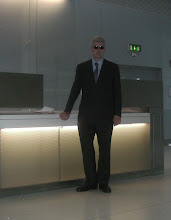
Its new Wise Labs brings the concept of telescope that allows the exploration true its interaction, Its like a self construction barrel as the probe fly. for example just say able to construct a plasma tube where the plasma assists the projectile item, so it could travel trough it. This would be something similar to a nervous system. Except using a projectile going true a tube for example with a laser guide it could be the equivalent of entering a black hole. This allows any item to be placed in space true a new pylon tower structure equivalent to a cable car that constructs its own passage true the use of plasma freshly made cable. This could allow probes to be placed near outer planets like Exo Planet's for example the planet Sadria so they could take up an orbit also fly to and from the moon at a flick of a switch boarding at an airport gate. A starting point for this would have to start within the CERN collector. This laboratory in Switzerland "building a nano barrel out of lasers" would allow control of a probe while travelling at super near light speeds its rather simple concept, until when its forwarded controls are been guided, its all from "Wise Labs Concept Designs" in the picture one can see a probe as it been launched from its space pad WLCD.
 When wise labs mentioned the concept of space platform with then the socking of liquids into space using tree like osmosis their was a lack of understanding. These futuristic engineering feats consist of a cable - they could be also known as a ribbons or tethers - of material stretching from the Earth’s surface into orbit. An anchor and Earth’s gravity at the lower end, and a counterweight and centrifugal force at the top end keep the elevator’s “cable” taut and stationary over ground station. with the use of robotic ‘climbers’ that would then pull themselves up the ribbon from the surface, through the stratosphere and out into space, potentially powered by lasers. The climbers could carry satellites up and bring minerals from the moon, or asteroids, back. They could take tourists into orbit or convey astronauts on the first part of their journey to the stars. No longer would space exploration be held back by gravity or rely on dangerous and expensive rockets.
When wise labs mentioned the concept of space platform with then the socking of liquids into space using tree like osmosis their was a lack of understanding. These futuristic engineering feats consist of a cable - they could be also known as a ribbons or tethers - of material stretching from the Earth’s surface into orbit. An anchor and Earth’s gravity at the lower end, and a counterweight and centrifugal force at the top end keep the elevator’s “cable” taut and stationary over ground station. with the use of robotic ‘climbers’ that would then pull themselves up the ribbon from the surface, through the stratosphere and out into space, potentially powered by lasers. The climbers could carry satellites up and bring minerals from the moon, or asteroids, back. They could take tourists into orbit or convey astronauts on the first part of their journey to the stars. No longer would space exploration be held back by gravity or rely on dangerous and expensive rockets.
One could take a ride for the cost of a first class airline ticket, exclaims David Horn, the Conferences Chair of the International Space Elevator Consortium (ISEC). Estimates suggest that the cost of sending cargo into space could plummet to around $100 per kilo gram. “A primary school could have a bake sale to cover the costs of sending a class science experiment into space.” Or, by selling enough cakes, even the entire class. ISEC has been organising space elevator conferences for the past ten years - ISEC will be held in Seattle later this month. They are attended by scientists, engineers and students from around the world, including those from various national space agencies like Nasa. There are also annual conferences in Europe and Japan and technical papers on various aspects of space elevators are published every year. "There’s global interest,” says Horn. “Reducing the cost to access space will change the global economy.” Which would be wonderful, but how much of this interest is just wishful thinking its a cheep way of maintaining floating space hotels.





No comments:
Post a Comment